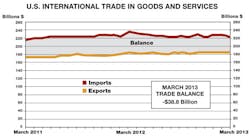With a drop in imports from China leading the way, the U.S. trade deficit in March fell to $38.8 billion, down from a revised $43.6 billion in February.
Imports from China declined by $5.5 billion in March. “The surge correction comes atop of a surge in February, and may be related to the timing of the Lunar New Year celebrations in China,” noted Michael Dolega, an economist with TD Economics. Dolega said the rising renminbi would likely “continue to put downward pressure on Chinese imports.”
The goods deficit decreased $4.6 billion from February to $56.1 billion. Exports of goods decreased $1.8 billion while the import of goods fell $6.4 billion.
NAM Chief Economist Chad Moutray, in the Shopfloor blog, observed that the narrowing goods deficit was due “mostly to non-petroleum factors.” For the first three months of 2013, the U.S. has imported just over 868 million barrels of oil, compared to over 960 million in the same period in 2012.
In March, the biggest declines in exports of goods occurred in food, feed and beverages ($1.1 billion); automotive vehicles and parts ($0.3 billion); capital goods ($0.3 billion); and consumer goods ($0.3 billion).
The decrease in the import of goods was led by drops in consumer goods ($3.4 billion); capital goods ($1.5 billion) and industrial supplies and materials ($1.4 billion).
March exports of advanced technology products grew $4.9 billion, while imports also grew by $3.4 billion. The total deficit in these products fell to $3.4 billion from $5 billion in February.
The trade deficit in goods with China fell to $17.9 billion in March, while the deficit with the European Union grew $1.1 billion to $9.9 billion and the deficit with Mexico increased $1 billion. Goods surpluses were registered with Hong Kong ($3.2 billion); Brazil ($1.7 billion) and Australia ($1.3 billion).
Looking ahead, TD Economics’ Dolega said U.S. exports have become increasingly competitive and this should improve the U.S. trade deficit in the future. “However, much of this won’t be seen until the current weak global economic backdrop improve," he cautioned.



